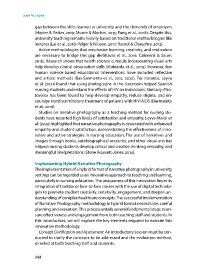Page 344 - International Perspectives on Effective Teaching and Learning in Digital Education
P. 344
Juan M. Leyva
gap between the skills learned at university and the demands of employers
(Hayter & Parker, 19; Moore & Morton, 15; Pang et al., 18). Despite this,
university teaching remains heavily based on traditional methodologies like
lectures (Lai et al., 18; Pelger & Nilsson, 17; Rasool & Chaudhry, 1).
Active methodologies that emphasise learning, creativity, and motivation
are necessary to bridge this gap (Betihavas et al., 16; Calimeris & Sauer,
15). Research shows that health science curricula incorporating visual arts
help develop clinical observation skills (Mukunda et al., 19). However, few
human science-based educational interventions have included reflective
and artistic methods (Bas-Sarmiento et al., 17, ). For instance, Leyva
et al. (1) found that using photographs in the classroom helped Spanish
nursing students understand the effects of HIV on individuals. Similarly, Pho-
tovoice has been found to help develop empathy, reduce stigma, and en-
courage nondiscriminatory treatment of patients with HIV/AIDS (Dermatoto
et al., 16).
Studies on narrative photography as a teaching method for nursing stu-
dents have reported high levels of satisfaction and empathy. Leyva-Moral et
al. () highlighted that narrative photography is associated with enhanced
empathy and student satisfaction, demonstrating the effectiveness of inno-
vative and active strategies in nursing education. The use of narratives and
images through books, autobiographical accounts, and other visual arts has
helped nursing students develop critical and creative thinking, empathy, and
meaningful interpretations (Stone & Levett-Jones, 14).
Implementing Hybrid Narrative Photography
The implementation of a hybrid format of narrative photography in university
settings can be regarded as an innovative approach to teaching and learning,
particularly in nursing education. The uniqueness of this innovation lies in its
integration of traditional face-to-face classes with the use of digital technolo-
gies to promote student creativity, sensitivity, engagement, and deepen un-
derstanding of complex healthcare concepts. The successful implementation
of Narrative Photography methodology in hybrid format necessitates careful
planning and execution. This process entails several fundamental steps to en-
sure effectiveness and engagement from both teaching staff and students. In
this introduction, we will explore the key elements required to execute this
innovative methodology.
Concept Clarification and Assessment: An introductory session must be con-
ducted to clarify the concepts to be addressed and the evaluation method,
directed at both teaching staff and students.
344

